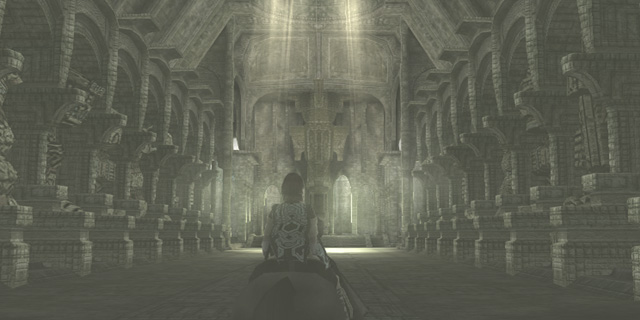
It’s very difficult to grab our attention these days. Gone are the days where gamers are thrilled by a simple screenshot. Our expectations are as high as ever, with emerging technology bringing us lightning-fast internet speed, HD graphics and constant social media bombardment. We have all the information in the world at our fingertips. Games play a huge part of the modern entertainment juggernaut, and the sheer capacity of information surrounding them is staggering. There are so many games, stories and characters out there for our potential enjoyment that it borders on unnecessary. I mean really, how many games do we need?
The amount of sensation we experience on a day-to-day basis is surely affecting our expectations. You hear statistics about how many advertisements we see each day, and nobody is ever pleased to hear how many it is. I’ve worked for an online marketing company for nearly six years, and the amount of impressions we see each month is so large, running a stats report can clog the entire system. So we have millions of gaming enthusiasts who have seen it all. How are we impressed? It has to have HD graphics, an incredible story, voice acting, great level design, action, romance… the whole nine yards. Right?
Sort of. In a world where “more” is all we can think of, sometimes it’s best that we slow down. Smell roses, if that’s your thing. One of the most brilliant games of the last, or any, generation of video games is Shadow of the Colossus, and it doesn’t bombard your senses with anything but pure, emotional enjoyment.
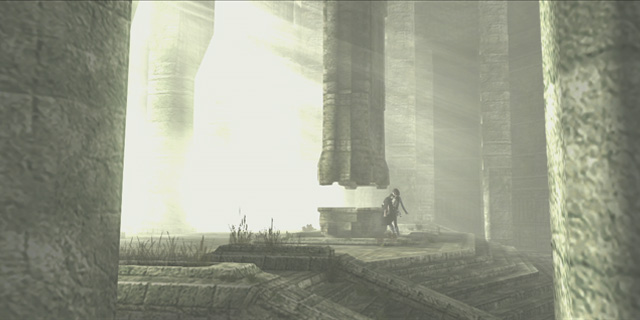
The game begins with a great example of show, don’t tell. You’re riding a horse along a huge, elevated road. We are interested right away, because the game makes us curious. Who are we? Who is the girl we have in our arms? Is she dead? Why are we in this strange, vast land? No answers are given. You prop her down at an altar and the game begins.
You’re not completely alone; your horse, Agro, is one of the best companions a gamer could have. He’s perfectly animated, he comes to you at a whistle, he helps you traverse the long hikes to the fights and he doesn’t shy away from the enemy. No back story is given, because it isn’t necessary. Agro is your continuity, your rock. The Colossi and environments change, but he never does.
Everything is quiet. There are no level announcements. The hero doesn’t make clever quips. You raise your sword to see a beam of light guiding you towards your next Colossi. Upon approaching them, you are in complete awe. We’ve seen big enemies in games before, but few have felt this big. Their movement, actions and sounds all match their look. They’re slow, lumbering and impossibly strong. Each boss is a combination of timing, puzzle solving, patience and aiming. Sometimes it will be an obvious solution, but more than often it isn’t. The music kicks up and the fight can seem endless, but never repetitive or dull. After defeating them, large black tentacles pierce your body. Are you dead?
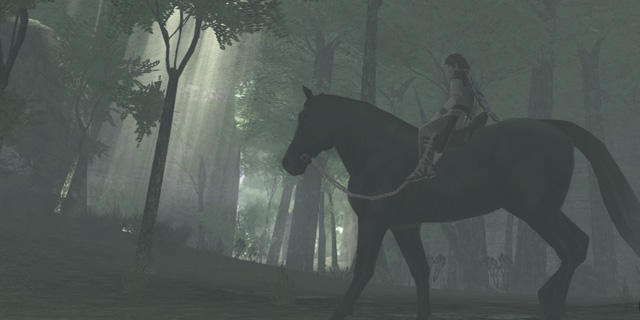
You awaken in the temple, beside the altar. Another Colossus defeated, another statue crumbles nearby. Shadowy figures look over your body. A voice gives you a hint about the nature of your next foe. What does it all mean? Why are you killing these creatures?
Part of the genius of the game lies in the fact that there are no other enemies. When you embark on your quest to defeat another Colossus, there aren’t smaller minions to get past. The Colossus isn’t a boss of anything. This gives you time to think about your last fight. You gallop along at a brisk pace, surveying the beautiful landscape. You can reflect. It’s peaceful. The anticipation grows as you approach the next Colossus, but you never feel rushed. They’re there, but they’re not going away anytime soon. But don’t you want to find out what happens to the girl?
That’s not to say that there aren’t thrilling moments. They come at almost every fight. Once the Colossus sees you, the tranquil moments of inner thought are gone. A weapon the size of a skyscraper is coming at you. You have to find its weak point and memorize patterns, and you have to time it perfectly. Pacing might be the key. There are periods where there is no music and very little stimulation. You’re put at ease, but you start to crave action.
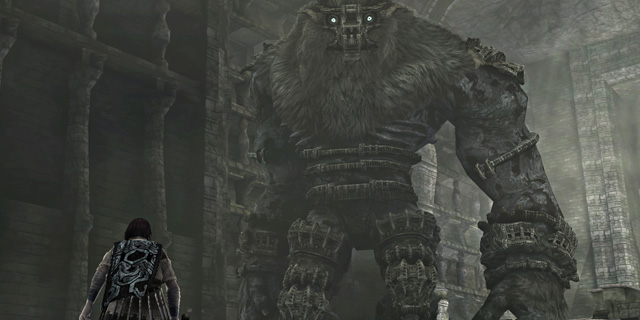
Most people talk about the first time they see a Colossus as one of the greatest parts of the game. I would never take anything away from that, because it truly is remarkable. But that didn’t make me jump out of my chair. Unlike two moments in the game, it didn’t make me squeal with uninhibited delight, the kind of behavior usually reserved for small children.
The sixth colossus, as described by the voice in the game, lusts for destruction but is no fool. He’s huge, but that’s par for the course. You run over barriers, trying to figure out how to climb up his torso and strike the killing blow. I remember I began to think of the hint. The Colossus is no fool. What does that mean? I ran and hid under the final structure, with nowhere else to run. I ensured his vision was blocked by positioning myself behind a pillar. He pauses, bends his knees and begins to look for me. His beard sways in the dust. His beard. I can grab onto his beard! I ran, and jumped, and grabbed, and smiled. The Colossus didn’t stand a chance.
I couldn’t believe how fast the answer to the puzzle hit me. It’s not a particularly difficult one; everybody knows that there are hundreds of games that are harder and more perplexing than Shadow of the Colossus. But the pacing of the battle and the simplicity of the solution is a fine example of how less can be more. Very few would take a look at the Colossus and immediately say that they have to climb the beard. He’s charging at you, so you run to the only place you can. He’s… what is he doing, bending over? He’s looking for me. None of the other Colossi had to do that, why is he….oh, I get it!
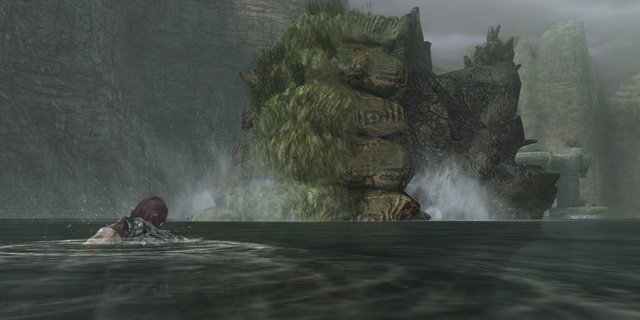
I only wish all my battles had these eureka instances. The 12th Colossus was an exercise in futility. I figured out all the steps except the first one: swim around him and climb up his back. I was overthinking.
My experience with the 13th Colossus was right out of a big-budget Hollywood movie. You ride out to the desert and are met with a giant, flying creature, a mix between a classic Chinese Dragon and a… butterfly? It’s hard to describe. The battle doesn’t start right away. Quiet violins punctuate that you’re not even close to the beast. He’s soaring a mile above you. How do you get up there? The white sacs on his underbelly are your only clue. Arrows fly, and…wait, is it dipping? Go.
You charge your horse forward, and the music dynamically changes from quiet violins to a full orchestra blaring encouragement. Drums are pounding. Your horse races across the sand, and your hold your breath as you get closer and closer to the beast. Sand is kicked up everywhere. You can’t see clearly. A wing. A hope. You jump.
When I jumped off my horse, at a full gallop, I couldn’t see anything. The wings of the Colossus kicked up so much sand that it made sight irrelevant. I just hit the button to jump and held the grab button and didn’t let go. A few seconds passed. The sand started to clear…and I was hundreds of feet in the air, hanging onto his wing with one arm. The ground disappeared quickly beneath.
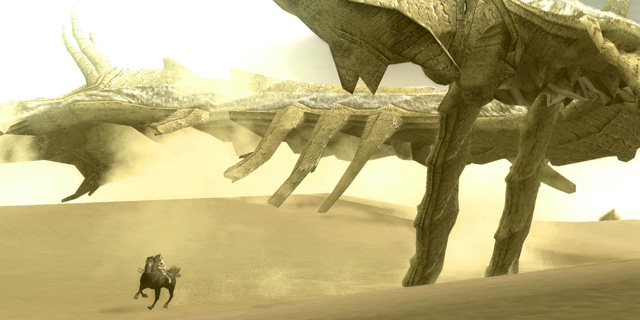
This is the kind of game that would be ruined by the kind of social interaction the PlayStation 4 wants to bring you. I’m all for connectivity, but a game like this needs to be experienced without spoilers. Nobody should tell you how to beat the fifth Colossus, or the 15th, or any of them. With all the incredible tools we have at our disposal to analyze and figure out how and why we play games, Shadow of the Colossus feels like an ancient classic. It should be immune to YouTube walkthroughs or spoilers, because the enjoyment comes from galloping across the terrain and the mystery that surrounds your character. From the transition between quiet beauty and shocking ferocity. From the stunning originality and timeless, perfect design.



















